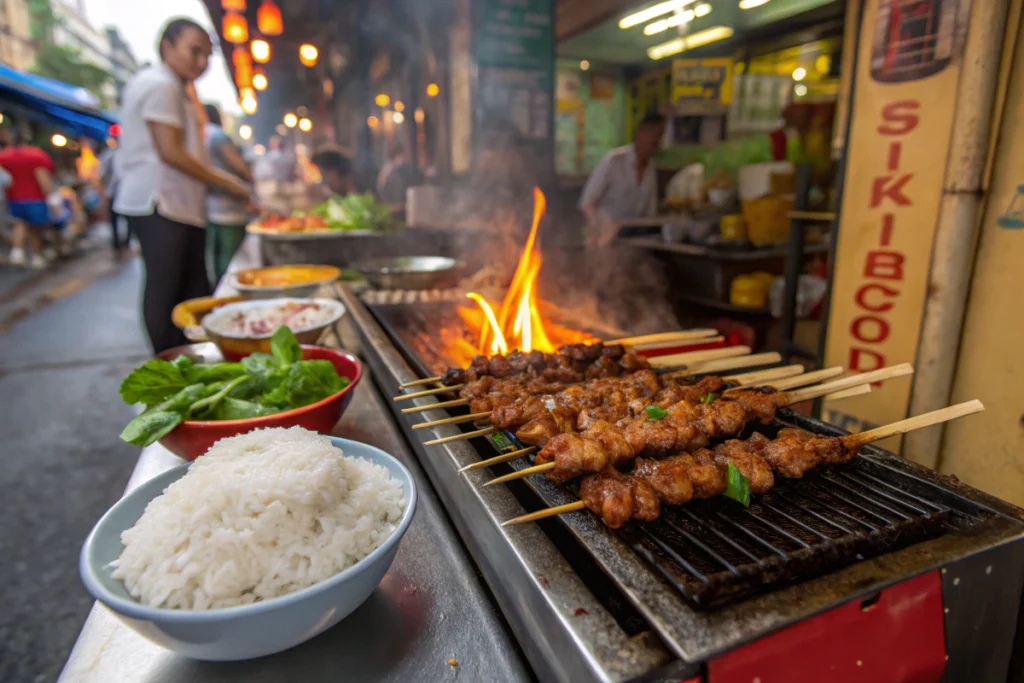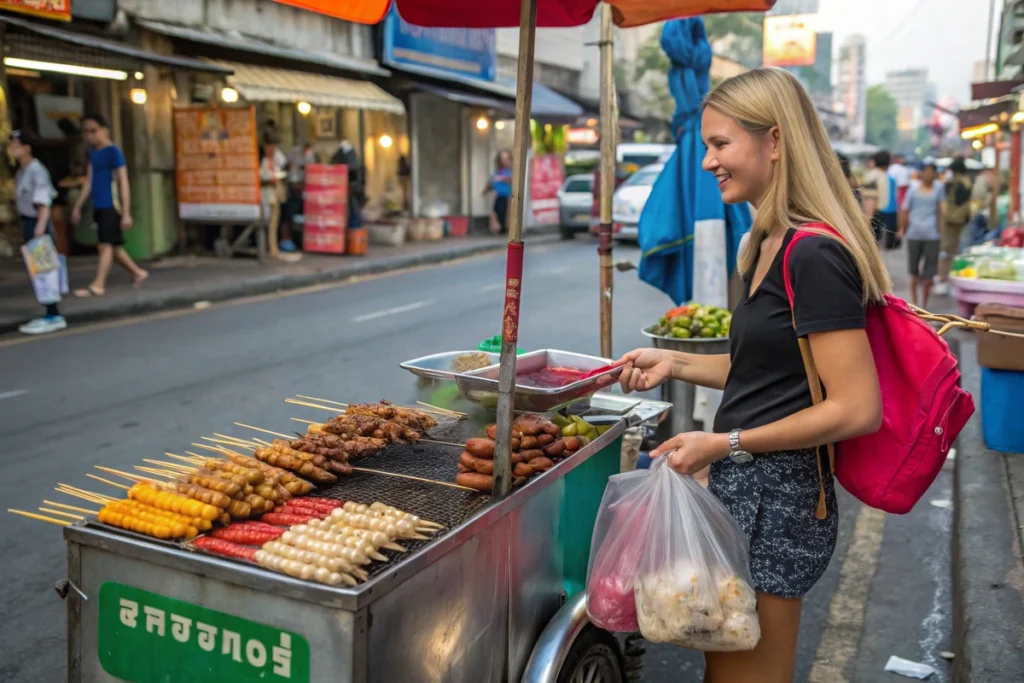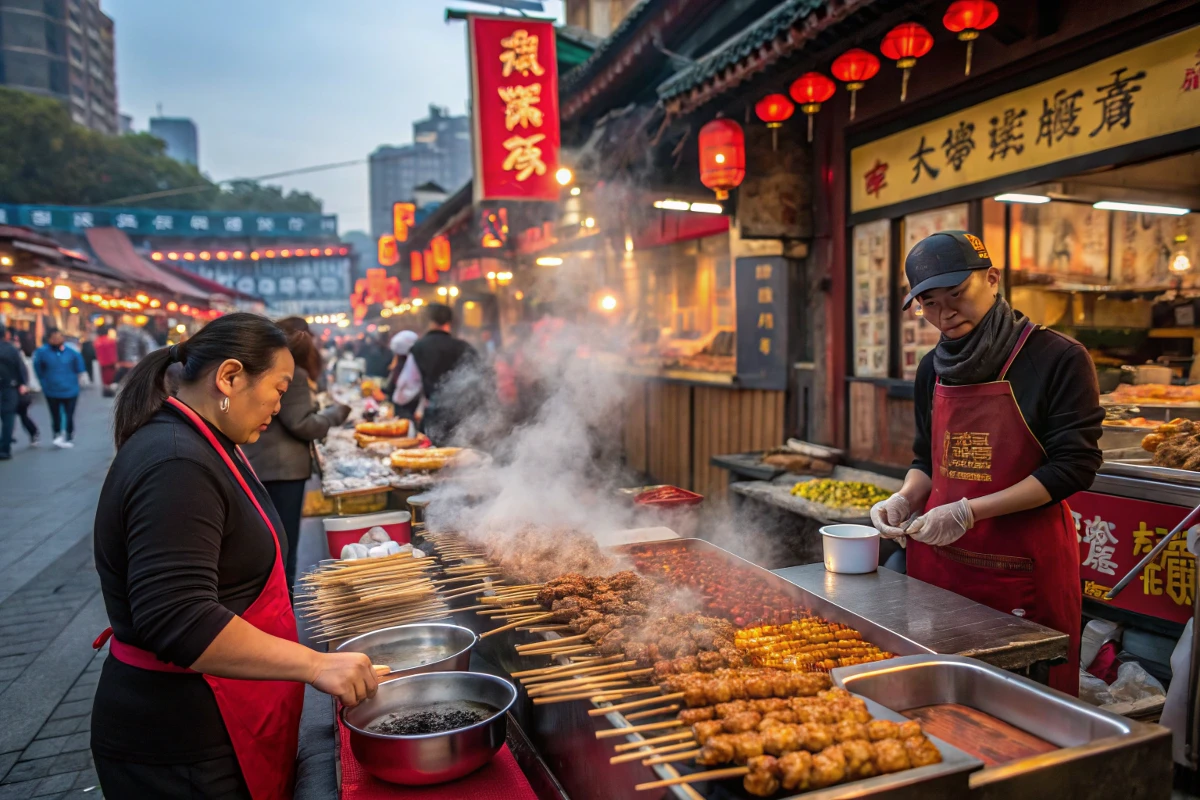Asian street meat isn’t just food; it’s a cultural experience. It weaves a tapestry of flavors, textures, and aromas that tell Asia’s culinary story. From Thailand’s bustling night markets to Vietnam’s charming street vendors and India’s smoky roadside grills, this article dives into the tantalizing world of Asian street meat in Asia. You’ll discover its regional varieties, cooking techniques, iconic dishes, and its role in tourism and local economies. Ready to explore this sizzling, savory journey? Let’s begin!
Introduction to Asian Street Food
The Cultural Importance of Street Food in Asia
In Asia, food is more than sustenance—it’s a way of life. Street food markets are not just for eating; they are hubs of social interaction. Locals and travelers gather there to enjoy fresh, affordable, and authentic meals. The diversity of Asian street meat reflects each region’s history and traditions. Skewered, grilled, or stir-fried, these dishes capture the soul of their creators and provide a glimpse into Asia’s vibrant culture.
Street Food: A Blend of Flavor and Tradition
Street food in Asia isn’t just about taste; it’s a sensory adventure. Skewers sizzle over open flames, while the aroma of marinated meats fills the air. Skilled vendors craft each dish with care, adding to the allure. Sweet-and-spicy marinades and herbs like lemongrass and coriander create bold flavors. Asian street meat blends culinary ingenuity with tradition, making it a must-try for anyone visiting Asia.
With its rich cultural significance and irresistible appeal, Asian street meat represents a delicious intersection of food, history, and community.
Regional Varieties of Asian Street Meat
Southeast Asia: Skewers, Satays, and BBQ Delights
Southeast Asia is a paradise for street food lovers. Countries like Thailand, Vietnam, and Malaysia boast a rich variety of Asian street meat dishes, each with unique flavors. In Thailand, moo ping (grilled pork skewers) is a crowd favorite, often paired with sticky rice and a tangy chili dip. Meanwhile, in Malaysia, satay reigns supreme. These flavorful skewers, marinated in a rich blend of turmeric, cumin, and lemongrass, are grilled to perfection and served with a creamy peanut sauce.
Vietnam, on the other hand, offers nem nướng, a delightful pork sausage grilled on sticks, often wrapped with herbs and rice paper. The smoky aroma of these grilled treats fills bustling markets, drawing locals and tourists alike. These dishes reflect the region’s love for bold spices, fresh herbs, and vibrant cooking styles.
East Asia: Dumplings, Bao, and Grilled Skewers
East Asia’s take on street meat is just as mesmerizing. Japan’s yakitori—bite-sized pieces of chicken grilled on skewers—is a must-try for anyone visiting. The sweet and savory glaze made of soy sauce, sake, and mirin elevates the dish to an art form. In Korea, bulgogi and kalbi skewers dominate the street food scene, offering a juicy, marinated flavor that keeps you coming back for more.
China’s bustling streets present another treasure: baozi and jianbing, savory buns and pancakes stuffed with marinated meats. Each bite delivers a perfect mix of tender meat and flavorful dough. These dishes, steeped in tradition, showcase the ingenuity and variety of Asian street meat in Asia.
South Asia: Kebabs, Rolls, and Spicy Meats
In South Asia, street meat boasts a spicier, more robust profile. India’s seekh kebabs, made with minced meat and bold spices like cumin and coriander, are grilled over open flames and served with mint chutney. Pakistan’s chicken tikka and beef kebabs also bring a fiery kick, often paired with naan or paratha.
Bangladesh offers its own twist with kati rolls, where grilled meat is wrapped in flaky flatbread for a portable, flavorful snack. These dishes showcase South Asia’s love for strong spices and rich marinades, making them an unforgettable part of the Asian street meat experience.
The Culinary Techniques Behind Asian Street Meat
Grilling, Skewering, and Marination Methods
The secret to delicious Asian street meat lies in the preparation. Grilling, the most common method, imparts a smoky aroma and crisp texture to meats. Vendors often use open flames or charcoal grills, allowing the meat to develop that signature charred flavor. Skewering is another popular technique, offering a convenient way to cook and serve smaller cuts of meat.
Marination is where the magic happens. Ingredients like soy sauce, fish sauce, turmeric, lemongrass, and chili paste create marinades that infuse the meat with bold flavors. These marinades reflect local tastes. Southeast Asia favors sweet and spicy flavors, while South Asia prefers earthy and fiery profiles.
Traditional Equipment: Woks, Smokers, and More
Asian street vendors often rely on simple, traditional tools that have been passed down for generations. Woks are used not just for stir-frying but also for deep-frying meats like crispy chicken or pork belly. Smokers and clay ovens, such as India’s tandoor, lend a distinct texture and flavor to meats, creating iconic dishes like tandoori chicken.
These techniques and tools make Asian street meat in Asia flavorful and deeply rooted in the region’s culinary heritage. It offers an authentic and irresistible experience.
Famous Street Meat Dishes Across Asia
Iconic Dishes in Thailand, Vietnam, and Malaysia
Here’s a quick comparison of some of the most popular Asian street meat in Asia from these three countries, showcasing their ingredients, cooking methods, and flavors:
| Dish | Country | Main Ingredients | Cooking Method | Flavor Profile |
|---|---|---|---|---|
| Moo Ping | Thailand | Pork, garlic, soy sauce, sugar | Grilled on skewers | Sweet, smoky, and savory |
| Bánh Mì Thịt Nướng | Vietnam | Grilled pork, baguette, veggies | Grilled and assembled fresh | Tangy, herbaceous, and rich |
| Satay Ayam | Malaysia | Chicken, turmeric, lemongrass | Grilled over charcoal | Spicy, earthy, and nutty |
These dishes capture the diverse flavors and cooking styles of Southeast Asia, reflecting the creativity and rich traditions of Asian street meat in Asia.

Japanese Yakitori and Korean Bulgogi
Japan’s contribution to Asian street meat is yakitori, a versatile grilled chicken dish. Whether seasoned with salty-sweet tare sauce or simply salted, each skewer is a bite-sized masterpiece. In Korea, bulgogi and kalbi showcase tender, marinated beef grilled to perfection. Bulgogi’s soy, garlic, and sesame flavors make it a standout dish, while kalbi’s sweet and savory glaze turns it into a true crowd-pleaser.
India’s Seekh Kebabs and Pakistan’s Tikka
The spicy, robust flavors of South Asia are perfectly embodied in India’s seekh kebabs and Pakistan’s chicken tikka. Both dishes are traditionally cooked over open flames, lending a smoky richness that’s irresistible. Paired with naan or mint chutney, these dishes highlight the deep love for meat in the region’s street food culture.
For more delicious recipes, check out Pollo Loco Recipe on Absolut Recipes for a savory twist on grilled chicken!
The Role of Street Meat in Asian Tourism
Street Food Markets as Tourist Attractions
Asian street food markets are not just places to eat—they are vibrant tourist attractions. Bangkok’s Chatuchak Market and Taiwan’s Shilin Night Market are globally famous for their variety of Asian street meat in Asia. Tourists visit these bustling hubs for the food, lively atmosphere, cultural insights, and local interactions.
Sustainability and Local Economies
Street meat vendors play a critical role in supporting local economies. These small businesses provide employment opportunities while promoting sustainability through the use of fresh, locally sourced ingredients. By enjoying Asian street meat, tourists support local families and help preserve traditional cooking techniques.

Health and Safety of Street Meat in Asia
Food Hygiene Practices
The vibrant world of Asian street meat in Asia comes with its share of health considerations. Street vendors, especially in bustling markets, often follow traditional hygiene practices to ensure food safety. Meat is usually cooked at high temperatures, which helps kill harmful bacteria. Many vendors also prepare food in small batches, reducing the risk of spoilage. Cleanliness varies between stalls, so tourists should choose vendors with visible hygiene practices. Look for clean utensils and fresh ingredients.
Tips for Safely Enjoying Street Food
To fully enjoy the wonders of Asian street meat, follow a few simple safety tips. Look for busy stalls; a high turnover of food often indicates freshness. Observe how the vendor handles raw and cooked items—cross-contamination is a red flag. Opt for piping hot food, as high heat ensures better safety. Lastly, trust your instincts. If something doesn’t look or smell right, it’s better to skip it.
FAQs About Asian Street Meat
What is the most popular street food in Asia?
The most popular street food in Asia varies by region, but some dishes stand out. For instance, in Thailand, Pad Thai and grilled skewers are widely loved. Similarly, in Japan, takoyaki (octopus balls) remains a favorite at food stalls. Meanwhile, baozi (steamed buns) dominate in China for their portability and taste. Furthermore, countries like India are famous for chaat, a tangy and spicy snack, which is enjoyed by locals and tourists alike. Overall, Asia’s street food scene is diverse, offering something for everyone.
Why is street food so popular in Asia?
Street food is incredibly popular in Asia for several reasons. Firstly, it is affordable, making it accessible to people from all walks of life. Secondly, the convenience of grabbing a quick meal while on the go appeals to busy locals and travelers. Moreover, street food showcases authentic and traditional flavors that represent the culture of each region. Additionally, the vibrant and social atmosphere of street food markets attracts people looking for a unique dining experience. Finally, the wide variety of dishes ensures there is something for everyone to enjoy.
What is the largest meat market in Asia?
The largest meat market in Asia is the Xinfadi Market in Beijing, China. Firstly, it serves as a critical hub for meat, seafood, and agricultural products, supplying much of Beijing’s food. Secondly, its massive size and infrastructure allow it to handle high volumes of trade daily. Moreover, the market is known for its efficient logistics and competitive pricing. Additionally, Xinfadi plays an essential role in stabilizing food prices in the region. Finally, it stands as a symbol of China’s growing food trade and distribution network.
What is Vietnamese street food?
Vietnamese street food is a diverse and flavorful aspect of the country’s cuisine. Firstly, dishes like banh mi (Vietnamese sandwich) are iconic for their fusion of French and local influences. Secondly, pho (noodle soup) is a popular street-side breakfast option enjoyed nationwide. Moreover, snacks like spring rolls and banh xeo (crispy pancakes) showcase the freshness of Vietnamese ingredients. Additionally, street food often includes tropical fruits and desserts, such as che, a sweet soup. Finally, the vibrant street food culture reflects Vietnam’s culinary traditions and social lifestyle.
What Should Be Avoided When Eating Street Meat?
While the flavors are irresistible, it’s essential to exercise caution. Avoid raw or undercooked meats, as well as stalls with poor hygiene standards. If you have dietary restrictions or allergies, be sure to ask the vendor about the ingredients.
Conclusion
Summarizing the Significance of Asian Street Meat
The journey through the world of Asian street meat in Asia highlights its role as more than just a culinary delight. From the bustling streets of Bangkok to the smoky grills of India, street meat reflects the heart of Asia’s rich cultural and culinary heritage. These dishes not only satisfy hunger but also offer a glimpse into the traditions, flavors, and artistry of each region.
Encouragement to Explore Asia’s Culinary Wonders
Whether you’re a seasoned foodie or an adventurous traveler, the vibrant world of Asian street meat promises an unforgettable experience. Each dish tells a story, blending spices, cooking techniques, and cultural influences that captivate the senses. So, the next time you find yourself in Asia, embrace the adventure and savor the unique flavors waiting for you on every street corner.
Would you like assistance with polishing the entire article, creating a featured image, or adding any final touches?

